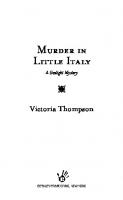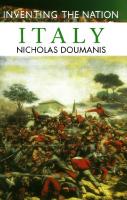
- Author / Uploaded
- Lauro Martines
Power and Imagination: City-States in Renaissance Italy
POWER AND IMAGINATION By the same author THE SOCIAL WORLD OF THE FLORENTINE HUMANISTS 196 3 LAWYERS AND STATECRAFT IN
1,548 88 41MB
Pages 388 Page size 597.771 x 844.562 pts Year 2010
Recommend Papers
File loading please wait...
Citation preview
POWER AND IMAGINATION
By the same author THE SOCIAL WORLD OF THE FLORENTINE HUMANISTS
196 3 LAWYERS AND STATECRAFT IN RENAISSANCE FLORENCE
1968 VIOLENCE AND CIVIL DISORDER IN ITALIAN CITIES, 1200-15°0
197 2 NOT IN GOD'S IMAGE: WOMEN IN HISTORY FROM THE GREEKS TO THE VICTORIANS
with Julia O'Faolain
1973 SOCIETY AND HISTORY IN ENGLISH RENAISSANCE VERSE
198 5
rOVVJER AND IMAGINATION CITY - STATES IN RENAISSANCE ITALY
BY
LAURO MARTINES
THE JOHNS HOPKINS UNIVERSITY PRESS BALTIMORE
© 1979, 1988 Lauro Martines All rights reserved Printed in the United States of America on acid-free paper
Originally published by Alfred A. Knopf, Inc., New York, in March, 1979, and simultaneously in Canada by Random House of Canada Limited, Toronto. First published in Great Britain by Allen Lane, 1980. Johns Hopkins Paperbacks edition, 1988, published by arrangement . with Alfred A. Knopf, Inc. 4 6 8 9 7 5 The Johns Hopkins University Press 27 15 North Charles Street Baltimore, Maryland 21218-4363 www.press.jhu.edu
Library of Congress Cataloging-in-Publication Data
Martines, Lauro. Power and imagination. Bibliography: p. Includes index. I. Italy-Politics and government-476-1268. 2. Italy-Politics and govemment-1268-1559. 3- Cities and towns-Italy-History. 4· Italy-Civilization-476-1268. 5. Italy-Civilization1268-1559. 6. City-states-Italy-History. I. Title. DG494·M37 1988 945 87- 29843 ISBN 0-8018-3643-3 (pbk.)
CONTENTS PREFACE TO THE JOHNS HOPKINS EDITION
IX
PREFACE
Xl
ACKNOWLEDGMENTS
Xill
I. THE ASCENT OF COMMUNES
Background Communes Emerge
7 7 12
II. THE EARLY COMMUNE AND ITS NOBILITY
22
Communes and Empire Consular Institutions The Nobility
22
III. THE COMMUNE AROUND 1200
34
26 29
Urban Crisis and Neighborhood Context Podestaral Government IV. POPOLO AND POPULAR COMMUNE
The Divisive Issues Popular Organization Discipline and Takeover The Changing Popolo
34 41
45 45 51 55 58
V. THE END OF THE POPULAR COMMUNE
Achievement Failure
62 62 66
VI. THE COURSE OF URBAN VALUES
Urban Space and Personality Florins: The Best of Kin Experience and Religious Feeling: An Anonymous Moralist VII. DESPOTISM: SIGNORIES
The Seizure of Power Signorial Government
72 72 79 86
94 94 102
v
Contents VIII.
THE COURSE OF POLITICAL FEELING
The Matrix: Local Feeling The Example of Brunetto Latini The Vanguard of Feeling I X. OLIG A RClIY: REN AI S SAN CE REPUB LIC S
The Republican Environment The Lesson of the Ambrosian Republic The Workings of Oligarchy
x.
III I I I
I 15
12 3
130 130 140 14 8
ECONOMIC TRENDS AND ATTITUDES
The Land Population and Trade Public Finance A Unity of Attitudes XI. HUMANISM: A PROGRAM FOR RULING CLASSES
The Program The Origins of Humanism The Problem of Objectivity Class and Group Conscience Ideological Themes XII. THE PRINCELY COURTS
Perimeters The Courtly Establishment A Paradise for Structuralists XIII.
ART: AN ALLIANCE WITH POWER
Patronage and Propaganda Social Positions and Mobility Social Identity into Artistic Style Manner and Style Space Real and Imaginary
2°7 210 21 4 218
218 221 229
24 1 24 1 244 249 259 27 1
XIV. INVASION: CITY-STATES IN LIGHTNING AND TWILIGHT
The Main Line ofEvents The Main Line of Failure VI
277 277 288
Contents xv.
THE HIGH RENAISSANCE: A DIVIDED CONSCIOUSNESS
The Key Experience: Contradiction Patronage in Danger Religion and Leadership Political Thinking: Man .Against Unreason The Language Question The Lure of Utopia
297 297
3°2
3°4 3 10 317 322
XVI. THE END OF THE RENAISSANCE
33 2
NOTES
339 345 353 357
BIBLIOGRAPHY SUPPLEMENTARY BIBLIOGRAPHY INDEX
Illustrations follow page 242
..
VII
PREFACE TO THE JOHNS HOPKINS EDITION
F
ashion in historical writing is shaped by long-term social and institutional urgencies. As we pick our way through the past, we look for what is troubling or buoying us up in the present; but we do so obliquely and unconsciously, for the things that spur us may be as unshapen as population imbalances, technologies, the inner city, feminism, or the flagrant abuse of political authority. Since the first edition of Power and Imagination (1979), the historical concern with populations and their attendant structures has persisted strongly, thus further underwriting an already dominant interest. Haunted by global questions, we want to know how past societies got on in their total environments-a grand commitment which has stimulated the combined study of economic, demographic, and ecological phenomena. Unsurprisingly, therefore, the last dozen years have brought a dramatic call for history as anthropological inquiry, evident above all in the current preoccupation with the history of ritual and popular culture. My appended supplementary bibliography lists the better pertinent work in this idiom. Changing numbers and recurrent patterns, volatile structures and obstinate continuities: these oppositions mark the interplay between historical demography and anthropology, between a concern with societal change over time and a concern with enduring matters of kinship, power, local space, sex, and generational relations. The combination has made for a vital dialectic, but it also invites a warning. When we draw anthropology into historical inquiry, we seem sometimes to verge on turning it into a search for "human nature." It is as if we would know the human species in its essence by ferreting out the basic push and patterns that appear to characterize all societies. If this really is the aim, then here, I fear, is a circuitous way to a new conservatism. To look for final truths in history is to flirt with canonizing current prejudice and value. Although demographers and would-be anthropological historians have thrown their nets widely, it may be argued that they have overlooked the IX
Preface act of enablement: the sustained scrutiny and deep analysis of texts, study of the sort best cultivated in tenacious socioliterary analysis. Yet "Where is history if not in the text?" And where is ritual if not in its texts? Even theory-if this be a study source for us-is little more than a rich and select compilation of texts. As historians, we, perhaps more than anyone else, still see as through a glass darkly. We were not there. In this dim light, accordingly, the next new direction in historical practice ought to be the literarysocial analysis of texts, even as historians rightly continue to raise questions drawn from demography and anthropology. The effort to get at the history of culture, elite or popular, is a quest for a vanished consciousness, and this can only be reconstituted-of course it never really can be-by the pertinacious analysis of an elaborate montage of literary and run-of-the-mill texts. This highlighting of a literary mode is my warrant for ending on a special note. The poetry of the Italian Renaissance, a vast continent, is still the undiscovered country for historians. When I come to recast and rewrite this book, as I expect to do, I shall hope to bring in much new political, social, and anthropological material, gleaned largely from the poetry of the age.
Lauro Martines London 1987
x
PREFACE
T
he story to be told here begins in the eleventh century, with the rise of warlike cities and their rush, under the leadership of communes, to seize local political power. The years around 1300 betray a break in development: urban Italy passes from one stage to another. The first stage is, however, an organic part of the period as a whole, for the Italian Renaissance issued forth in two "grand" stages. The first, lasting to about I 300, saw the laying of a basic groundwork: the physical building of cities and the rise of a new economy, a new society, new states, and a new set of vivid, shaping values. In the second stage, extending from about 1300 to the late sixteenth century, "high" culture-literature, art, and ideas-pushed forward and became more prominent, more important. But the achievement of the second stage was vitally rooted in the resources and values of the first. No other validation is needed, it seems to me, for giving the eleventh and twelfth centuries a place in this history. The title Power and Imtlgination is my way of referring to, and altering, the more conventional distinction between "society" and "culture." In telling a story which courses across five centuries, I was driven to pursue a central theme, a thread more easily visible than "society." I chose to center attention on the fortunes of "power" because, in tracing the movement of political authority, I was also compelled, all the way along, to track the direction of social and economic change. And I chose "imagination" over "culture" because my supreme concern is with relations between dominant social groups (power) and the articulated, formal, refined, or idealizing consciousness of those who speak for the powerful. In this interplay, the workings of imagination tend to be foremost.
Lauro Martines Florence, Los Angeles, London 1966- 1 97 8
Xl
ACKNOWLEDGMENTS
To Gene Brucker, of the University of California, Berkeley, for a generous commentary on the manuscript. To Samuel Y. Edgerton, of the Fine Arts Department of Boston University, for his critical reading of Chapter XIII. To students present and past, in the University of California at Los Angeles, who suffered the themes of this book. To the National Endowment for the Humanities, for a senior fellowship (and freedom) in 1971. And finally to the University of California, for research grants across a decade. To these all, my sincere thanks and gratitude.
L.M.
XIII
C 1TJ ES
==
THE LEAVING COMMUNES ABOUT 1'200
JTAlY: POLITICAL BOUNDARIES ABOUT 1000
Territories under theoretical Byzantine rule
Trent SfTTJanw
•
B ' UfH resc~ Tunn. \1"e nell'. ~ L. • Cnmt1. f . X""H'~n ' LOd~ • L~ VeronaVt£fnza Novam Mt'l., lJ1 o
•
~~;1
Territvries dirlCt1!f under Byzantine ruu
t~:~:









